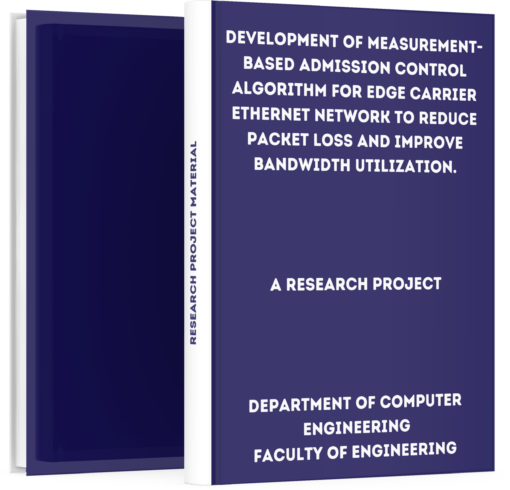Development of Measurement-based Admission Control Algorithm for Edge Carrier Ethernet Network to Reduce Packet Loss and Improve Bandwidth Utilization.
₦3,000.00
If you are interested in getting this project material “Development of Measurement-based Admission Control Algorithm for Edge Carrier Ethernet Network to Reduce Packet Loss and Improve Bandwidth Utilization”, click on the DOWNLOAD BUTTON to make payment and the file will be delivered to your email immediately after confirmation.
Description
– Development of Measurement-based Admission Control Algorithm for Edge Carrier Ethernet Network to Reduce Packet Loss and Improve Bandwidth Utilization –
Download Development of Measurement-based Admission Control Algorithm for Edge Carrier Ethernet Network to Reduce Packet Loss and Improve Bandwidth Utilization. Computer Engineering students who are writing their projects can get this material to aid their research work.
Abstract
Admission Control is a vital component for end-to-end Quality of Service (QoS) delivery in a packet flow network. It is more effective when implemented at the edge of the network. The edge of a mobile network is dominated by a multiplexer which either uses Synchronous Digital Hierarchy (SDH) or Wavelength Division Multiplexing (WDM) for transport.
The edge of the carrier Ethernet network suffers QoS due to packet loss and underutilization of bandwidth. Measurement-Based Admission Control (MBAC) Algorithm which reduced the IP Packet Loss Ratio (IPLR) of WDM system by 30.36% and SDH system by 25.34% was set to be achieved in this work.
Introduction
Wireless mobile network services have evolved over time from low bandwidth consumption services to high bandwidth consumption services (Cisco, 2016).
This has forced network providers to upgrade their mobile backhaul to IP-based because these high bandwidth consumption services (like streaming media, video, and interactive gaming) are IP-based that require an IP-based network.
These different services require Quality of Service (QoS) which must be supported by a well-defined IP and Ethernet-based network.
A well-defined IP- and Ethernet-based network which should satisfy the QoS requirements of these services must exercise admission control at the edge and core of its network to control the amount of traffic injected into its network (Heena et al, 2011).
How to Download this Project Material
First, note that we are one of the best and most reliable online platforms because we don’t retain any of your personal information or data as regards making payments online.
PRICE: ₦3,500 ₦3,000 (Three Thousand Naira Only)
Make a bank deposit or mobile transfer of ₦2,000 only to the account given below;
Bank Name: UBA Account Number: 1022564031 Account Name: TMLT PRO SERVICES
After making the payment, CLICK HERE to send the following on WhatsApp;
- Depositor’s Name or Screenshot of Payment
- Name of the Past Question
- Active Email Address
or Call Us On +2348082284439 Once your details have been received and your payment confirmed by us, you will receive the past question in your email or WhatsApp within 5 Minutes.
Guarantee of Getting the Material
We understand that due to the high rate of fraud, many people are afraid of making purchases online but be rest assured that PastExamQuestions will deliver your material after payment.
Once your details have been received and your payment confirmed by us, you will receive the past question in your email or WhatsApp.
Give us Feedback
Have we been able to satisfy you? How well do you think the material will be helpful after having gone through it? Does the price worth the material?
Let’s hear from you! We recommend that our customers give feedback at the end of every transaction to enable us to serve better. You can do this by clicking the review button on this page.
Where is the review button? >> Just scroll up to where you see reviews





Reviews
There are no reviews yet.